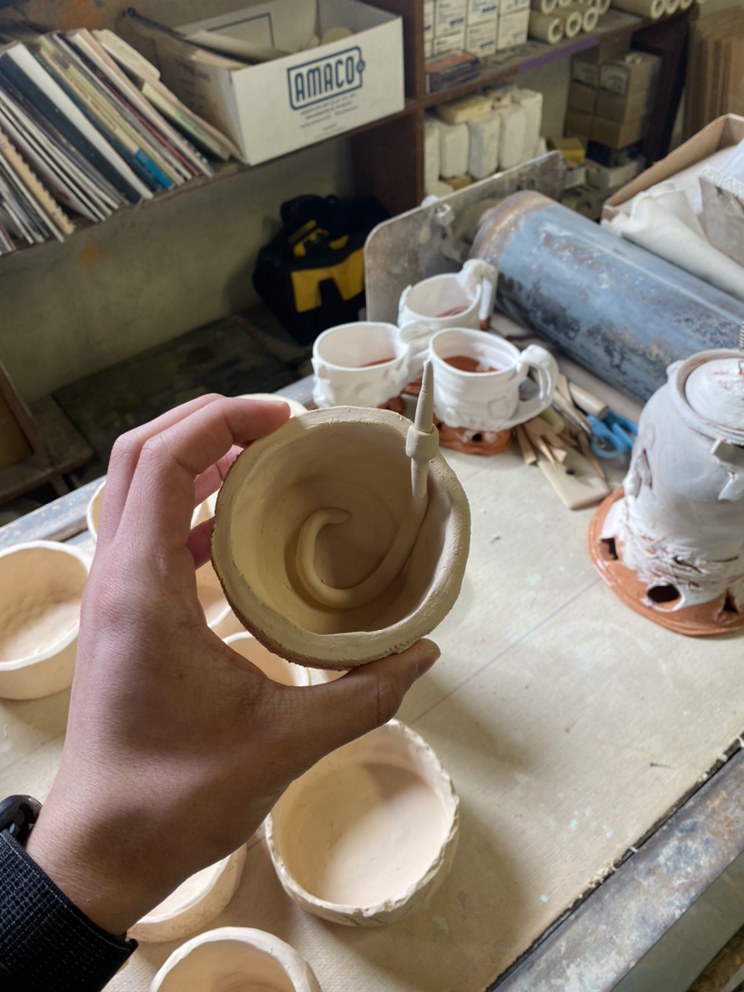
By Nat Wilk, Editor in Chief
Pictures taken by Kenneth Glidden, gathered by Nat Wilk
McKendree University boasts all sorts of creative courses for students in the arts. From film and photography to drawing and sculpting, the art program covers a wide range of skills within the artistic field. Considering all the fantastic art classes offered here, I thought it would be fascinating to get an inside look at a class I had never heard anything about: ceramics.
Seniors Camryn Anderson and The Review’s own Kenneth Glidden (Kenny) are two students that are in ceramics courses. I asked them about the project they’ve made that they are most proud of. “I am most proud of the Jomon that I created,” Camryn says. “I am also very proud of the flower pots I created.” Jomon pottery is a type of pottery from Japan’s Neolithic period, characterized by their “cord markings” featured on the ceramics (1). Practicing types of ancient pottery is just one of the many aspects of art at McKendree.
“So far in the class we have made pinch pots, slab cups with handles and we’re currently working on a large coil project,” Kenny says. “The one I am most proud of is a pinch pot I made that has a dirt-like texture on the outside with a worm inside the cup poking its head out.”
While pinch pots are formed using a lob of clay and using your fingers to pinch and shape (2), slab cups are made using slab construction, which is “a construction technique in which clay is rolled into thin sheets and manipulated into shapes” (3).
As for the coil project Kenny mentioned, that is referring to pottery made with snake-like rolls of clay – for example, to make a coil pot, one would layer rolls on top of the main walls of the pot to extend its shape and manipulate its form (4). The range of techniques from both of these students’ responses truly portrays the range of skills they get to practice within the ceramics class.
Because of the variety of skills and projects the ceramics class has, some types of pottery are more challenging than others. “The most challenging thing for me was the slab cups,” Kenny said. “The slab technique used to flatten the clay is kind of challenging and then connecting the ends to make it a cylinder is a delicate process.”
Camryn states she had trouble with creating throwing cups on the pottery wheel. “Learning to throw cups is difficult because you have a natural tendency to want to go out with the clay, but you have to stay in for the mugs.”
Throwing is a method where the artist throws wet clay onto the pottery wheel, and while the wheel rotates, the artist must form the shape from the inside bottom of the vessel using a series of slow and careful techniques (5). Most of us have probably seen this method used in television and movies – they sure make it look much easier than it sounds!
With the variety of projects the ceramics courses offer, there is something in it for everyone; including how fun it sounds to create your own masterpieces. “My favorite part about ceramics is being able to work with clay – it’s a wonderful stress relief and it’s nice to see your creations come to life,” Camryn explains. Art means something different to everyone, but on top of the technique and work it takes, you should be enjoying yourself!
Kenny comments on his favorite part of the class: “The freedom the teacher [Andrew Koester] gives us – he gives us a demo on how to do the assignment we’re working on and some basic parameters (height and diameter) and then just lets us get to work.” He continued, “We get to use our own creativity and work at our own pace.”
Ceramics is just one of the many courses McKendree offers in the art field – if you’re interested in ceramics or another art class, try it out! You’ll walk away with a better understanding of the arts and gain an appreciation for the many techniques and mediums you can work with. There is no limit to your imagination!
References
1-https://www.metmuseum.org/toah/hd/jomo/hd_jomo.htm
2-https://en.wikipedia.org/wiki/Pinch_pot
3-https://www.cusd80.com/Page/25954





